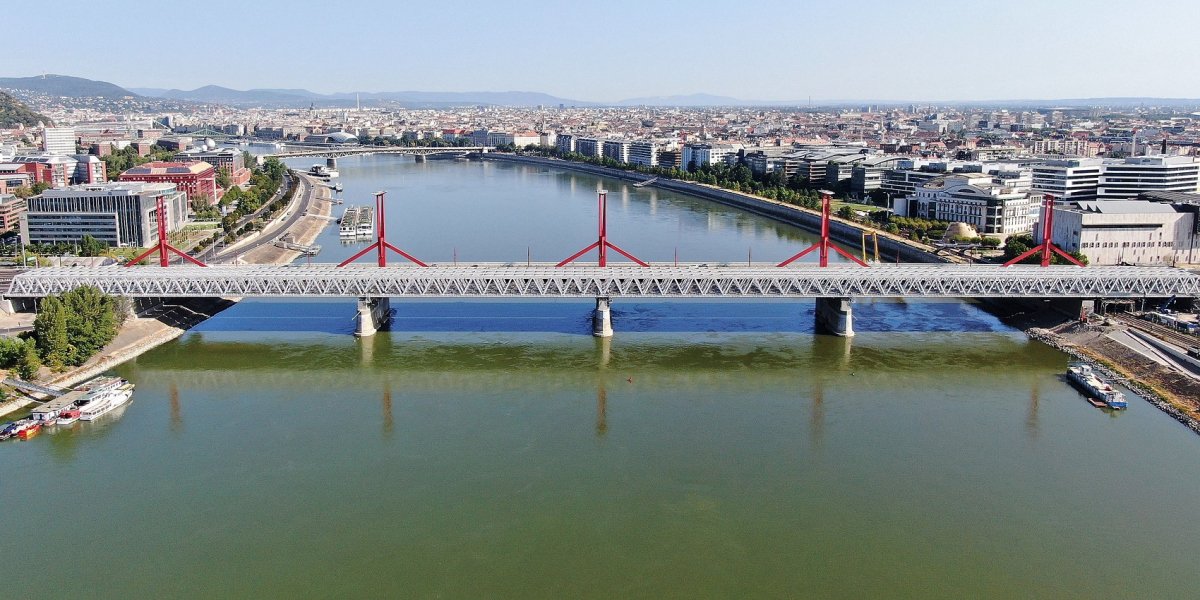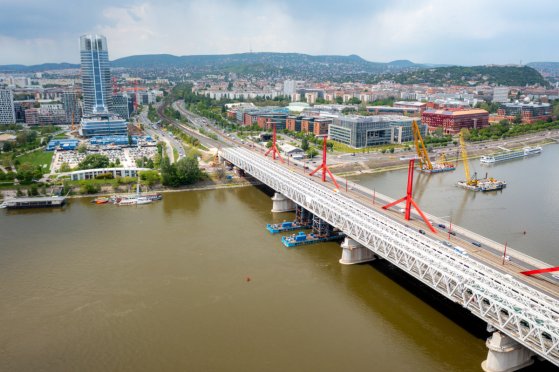 The „intertwined history” of the bridges and the city of Budapest
Which ideas and events have shaped the fate of bridges of Budapest and the cityscape? Alongside many other interesting facts, this question is also answered this newly published book by the Budapest City Archives, which introduces the history of bridges in Budapest.
The „intertwined history” of the bridges and the city of Budapest
Which ideas and events have shaped the fate of bridges of Budapest and the cityscape? Alongside many other interesting facts, this question is also answered this newly published book by the Budapest City Archives, which introduces the history of bridges in Budapest.
Southern Connecting Railway Bridge
 Bridge inauguration: the renovated and expanded southern connecting railway bridge was handed over
Bridge inauguration: the renovated and expanded southern connecting railway bridge was handed over
August 4, 2022 at 5:30 PM
The first railway crossing was originally built in 1877 on the part next to today's Rákóczi bridge, the bridge has been rebuilt several times since then, expansion of its capacity was proposed as early as the 1910s, but it was only recently expanded to three tracks. The line is one of the country's most important east-west railway connections. 150 passenger and 100 freight trains cross the approximately 500-meter-long bridge every day, and 2.8 million passengers used it last year.
The last element of the Southern Connecting Railway Bridge was replaced
May 6, 2022 at 5:30 PM
The third structure of the new connecting railway bridge is now passable, as its last piece has been replaced. The rail and other works will then be carried out and the trial load is expected to take place in early August. This marked another milestone in the development of the Southern Circuit, which aims to increase the utilization of suburban trains, thereby reducing car traffic in the capital.
By mid-December, the Southern railway connecting bridge could be fully completed
October 13, 2021 at 7:00 PM
The closing piece of the steel structure of the new, Southern railway connecting bridge was added, thus completing the next phase of the renovation and expansion of the Danube railway bridge. According to the plans, from mid-December, trains will be able to run over the Danube on the two new bridge structures.
Built on a freight station: the Millennium City Centre
November 17, 2020 at 9:00 AM
Budapest is a city of constant change. This is especially true for parts of the city that were once industrial centres or served these industries. The decaying remains of 100–150-year-old factories are often called rust belts. While the future of many of these areas remains uncertain, some examples have been completely transformed and given an entirely new lease on life. Over the past 25 years, the Millennium City Centre has sprouted where the Danube-Bank Freight Station once stood and has become such an area.
More articles
 The „intertwined history” of the bridges and the city of Budapest
Which ideas and events have shaped the fate of bridges of Budapest and the cityscape? Alongside many other interesting facts, this question is also answered this newly published book by the Budapest City Archives, which introduces the history of bridges in Budapest.
The „intertwined history” of the bridges and the city of Budapest
Which ideas and events have shaped the fate of bridges of Budapest and the cityscape? Alongside many other interesting facts, this question is also answered this newly published book by the Budapest City Archives, which introduces the history of bridges in Budapest.
 The Bridge Report, which brought a turning point in the history of Budapest
A travel report that changed the history of Pest and Buda, as well as Hungary. The little book contributed to the change of half a thousand years of legal customs and the implementation of an investment of unprecedented size and technical quality. This book was The Bridge Report [Hídjelentés in Hungarian].
The Bridge Report, which brought a turning point in the history of Budapest
A travel report that changed the history of Pest and Buda, as well as Hungary. The little book contributed to the change of half a thousand years of legal customs and the implementation of an investment of unprecedented size and technical quality. This book was The Bridge Report [Hídjelentés in Hungarian].
 Drama on the university wall - The heroic monument was planned 95 years ago
In the constant hustle and bustle of the Egyetem Square in Pest, the students may not even notice the monument that decorates the short section of wall between the church and the central building of ELTE. However, it commemorates their predecessors, the heroes who fought for their country in World War I, and those who heroically helped them. The first design of the dramatically collapsing soldier was born in 1928, ninety-five years ago.
Drama on the university wall - The heroic monument was planned 95 years ago
In the constant hustle and bustle of the Egyetem Square in Pest, the students may not even notice the monument that decorates the short section of wall between the church and the central building of ELTE. However, it commemorates their predecessors, the heroes who fought for their country in World War I, and those who heroically helped them. The first design of the dramatically collapsing soldier was born in 1928, ninety-five years ago.



